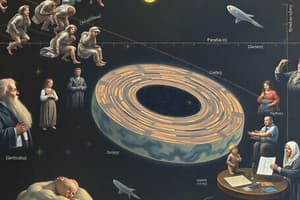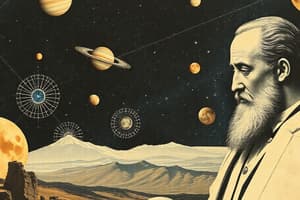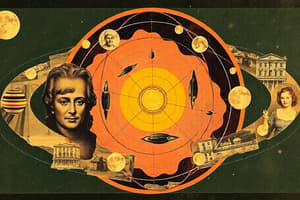Podcast
Questions and Answers
Which of the following is a contribution of Nicolaus Copernicus to the study of the universe?
Which of the following is a contribution of Nicolaus Copernicus to the study of the universe?
- Discovering Uranus and double stars.
- Proving the existence of dark matter.
- Developing the theory of relativity.
- Proposing that the Sun is the center of the solar system and the planets move around it. (correct)
Johannes Kepler's major contribution to astronomy involved:
Johannes Kepler's major contribution to astronomy involved:
- The discovery of the law of universal gravitation.
- Demonstrating that planetary orbits are elliptical, not circular. (correct)
- Proving the existence of dark nebula.
- Detailed observations of sunspots and lunar mountains.
What significant advancement in astronomical observation is attributed to Galileo Galilei?
What significant advancement in astronomical observation is attributed to Galileo Galilei?
- Developing the first reflecting telescope.
- Calculating the precise measurements of planetary distances.
- Being the first to effectively use a telescope to observe celestial bodies in detail. (correct)
- Formulating the laws of motion.
Which of the following concepts is Sir Isaac Newton best known for in the field of astronomy and physics?
Which of the following concepts is Sir Isaac Newton best known for in the field of astronomy and physics?
William Herschel is credited with which discovery that expanded our understanding of the solar system?
William Herschel is credited with which discovery that expanded our understanding of the solar system?
Albert Einstein's theory of relativity revolutionized physics by introducing new concepts about:
Albert Einstein's theory of relativity revolutionized physics by introducing new concepts about:
What did Edwin Hubble discover about the movement of galaxies that significantly contributed to our understanding of the universe?
What did Edwin Hubble discover about the movement of galaxies that significantly contributed to our understanding of the universe?
Stephen Hawking is best known for his work related to:
Stephen Hawking is best known for his work related to:
Vera Rubin's research provided key evidence for the existence of:
Vera Rubin's research provided key evidence for the existence of:
What is the main concept behind the Big Bang Theory?
What is the main concept behind the Big Bang Theory?
What is the current estimated age of the universe, based on the rate of its expansion?
What is the current estimated age of the universe, based on the rate of its expansion?
Which of the following describes a 'Closed Universe' scenario?
Which of the following describes a 'Closed Universe' scenario?
What evidence suggests the existence of dark matter?
What evidence suggests the existence of dark matter?
What property defines RR Lyrae variables?
What property defines RR Lyrae variables?
What is the primary characteristic of Cepheid variables that makes them useful for measuring cosmic distances?
What is the primary characteristic of Cepheid variables that makes them useful for measuring cosmic distances?
What type of galaxy is the Milky Way classified as?
What type of galaxy is the Milky Way classified as?
What does AGN stand for, and what is its significance in astronomy?
What does AGN stand for, and what is its significance in astronomy?
What is a protostar?
What is a protostar?
What is the defining characteristic of a main sequence star?
What is the defining characteristic of a main sequence star?
What is a black dwarf?
What is a black dwarf?
Flashcards
Nicolaus Copernicus Contributions
Nicolaus Copernicus Contributions
Quietly studied planetary movement, proposed Earth's rotation and heliocentric model.
Johannes Kepler's Discovery
Johannes Kepler's Discovery
Planets move in elliptical orbits, not perfect circles.
Galileo Galilei's Observations
Galileo Galilei's Observations
Used telescope effectively, discovered moon mountains, Venus phases, Jupiter moons, observed sunspots.
Isaac Newton's Laws
Isaac Newton's Laws
Signup and view all the flashcards
William Herschel's Discoveries
William Herschel's Discoveries
Signup and view all the flashcards
Albert Einstein's Relativity
Albert Einstein's Relativity
Signup and view all the flashcards
Edwin Hubble's Discovery
Edwin Hubble's Discovery
Signup and view all the flashcards
Stephen Hawking's Proposal
Stephen Hawking's Proposal
Signup and view all the flashcards
Vera Rubin's Discovery
Vera Rubin's Discovery
Signup and view all the flashcards
Big Bang Theory
Big Bang Theory
Signup and view all the flashcards
Age of the Universe
Age of the Universe
Signup and view all the flashcards
Possible Universe Outcomes
Possible Universe Outcomes
Signup and view all the flashcards
Dark Matter
Dark Matter
Signup and view all the flashcards
Variable Stars
Variable Stars
Signup and view all the flashcards
RR Lyrae Variables
RR Lyrae Variables
Signup and view all the flashcards
Cepheid Variables
Cepheid Variables
Signup and view all the flashcards
Galactic Centers
Galactic Centers
Signup and view all the flashcards
Dark Nebula
Dark Nebula
Signup and view all the flashcards
Protostar
Protostar
Signup and view all the flashcards
Main Sequence Star
Main Sequence Star
Signup and view all the flashcards
Study Notes
Contributions of Early Astronomers
- Nicolaus Copernicus (1540) studied planetary movements and stars
- Copernicus determined Earth rotates on its axis, causing day and night
- Copernicus proposed the Sun is at the center, with planets moving around it
- Johannes Kepler (1571) stated planets move in ellipses
- Galileo Galilei (1609) used the telescope effectively and discovered:
- Mountains on the moon
- Phases of Venus
- Moons of Jupiter
- Galileo Galilei observed the Sun's rotation by following sunspots
- Galileo Galilei was forced to recant his findings
- Sir Isaac Newton (1665) formulated the law of gravitation
- Bodies attract each other, force proportional to masses and inversely proportional to distance
- Newton determined the moon causes tides
- Newton discovered prisms separate light, spectral analysis of stars
- William Herschel (1781) discovered Uranus and the existence of double stars -Herschel determined the general shape of the Milky Way
- Albert Einstein (1919) developed the theory of relativity Motion, time, and distance are relative
- Einstein explained the universe with curved space-time
- Edwin Hubble (1950s) found galaxies moving away, indicating an expanding cosmos
- Stephen Hawking (2000s) proposed the universe had a beginning and will have an end
- Vera Rubin (1970s) proved the existence of dark matter
- Rubin studied the motion of stars in the Andromeda galaxy
The Big Bang Theory
- The Big Bang Theory is a scientific explanation for the beginning of the universe
- Cosmic background radiation is evidence supporting the Big Bang Theory
Age of the Universe
- Scientists estimate the universe's age using Edwin Hubble's theory of expansion
- The estimated age of the universe is 13.7 billion years old
Possible Outcomes for the Universe
- Open Universe: Expansion will never stop
- Closed Universe: Expansion stops and turns to contraction
- Flat Universe: Expansion slows to a halt infinitely but never contracts
Dark Matter
- Dark matter consists of subatomic particles not yet found
- Fred Zwicky observed galaxies in the Coma Cluster moving faster than their escape velocity which provided evidence for dark matter
Large Hadron Collider (LHC)
- The LHC is the most powerful particle accelerator
- It has possibly discovered hints of new physics
Variable Stars
- Variable stars pulsate in brightness due to expansion and contraction of outer layers
- They help determine distances to cluster stars
RR Lyrae Variables
- These stars have pulsation periods between 1.5 hours and 1 day
- They possess the same luminosity on average
Cepheid Variables
- These stars have pulsation periods between 1 and 100 days
- Their luminosity doubles from dimmest to brightest
Galaxy Centers
- Supermassive black holes occupy the center of most galaxies
- Sagittarius A* is at the Milky Way's center and is a supermassive black hole
- It has 2.6 million times the Sun's mass but is smaller than our solar system
Galaxy Classifications
- Disk-like galaxies include spiral galaxies, barred spiral galaxies, and flat disks
- Elliptical galaxies are not flattened and lack spiral arms
- Irregular galaxies do not have a distinct shape
Our Galaxy
- We belong to a disk-like galaxy, specifically a barred spiral galaxy
Active Galactic Nucleus (AGN)
- AGN is the core of an active galaxy with highly energetic objects
- Quasars are examples of extra-bright AGNs that are very luminous and distant
Dark Nebula
- A dense cloud of gas and dust that blocks light
Protostar
- The earliest stage of star formation before nuclear fusion which forms from a collapsing cloud of gas and dust
Main Sequence Star
- A star in its longest, most stable phase that generates energy by fusing hydrogen into helium
Supergiant/Red Giant
- Stages in a star's life cycle after hydrogen fuel is exhausted
White Dwarf
- The remnant core of a red giant after shedding its outer layers
Black Dwarf
- A cold, dark, dead remnant of a white dwarf
Supernova
- A massive explosion when a star reaches the end of its life cycle
Neutron Star/Pulsar
- A remnant core of a massive star after a supernova
Black Hole
- A region where gravity is so intense that nothing can escape
Star Death
- A star's mass dictates its life cycle and how it will die
Types of Spectra
- Continuous Spectrum: Light with no breaks
- Emission Spectrum: Contains bright lines from emitted wavelengths
- Absorption Spectrum: Shows dark bands from light passing through a substance
Parallax
- Parallax is the apparent shift in position due to the observer's motion
- Closer stars have a larger parallax shift, measured by angle
Magnitude
- Apparent magnitude refers to how bright a star appears
- Absolute magnitude refers to how bright a star would appear at a distance of 10 parsecs
- Luminosity is the energy output from a star's surface per second
Telescopes
- Kepler searches for Earth-like exoplanets
- Hubble observes distant galaxies, stars, nebulae, and other phenomena
- Spitzer observes the universe in infrared wavelengths
- James Webb observes the early universe, galaxy formation, and exoplanet atmospheres
Telescope Types
- Refracting telescopes use lenses to form images
- Reflecting telescopes use mirrors to form images
NASA Spinoffs
- Satellites: Originally for NASA and military communication
- Smoke Detectors: To detect fire in spacecraft
- Thermal Gloves: For space exploration
- Firefighter equipment: For fighting fires on spacecraft
NASA and CSA
- NASA conducts research and development in space exploration and scientific discovery
- CSA coordinates Canadian space activities, research, and technology
International Space Station (ISS)
- The ISS is a platform for international collaboration and research in space
Space Transportation System (STS)
- STS aimed to provide regular space access for science and human spaceflight to deploy satelites
Future NASA Missions
- Moon to Mars Project: Study human response in deep space
- Testing tools, instruments, and equipment for future Mars missions on the moon
- Lunar Gateway Project: Sustaining human space exploration goals
- CSA contribution is the Canadarm 3, lunar surface access, and Mars missions
Current NASA Mission
- The James Webb Space Telescope observes distant galaxies, exoplanets, and the early universe
Studying That Suits You
Use AI to generate personalized quizzes and flashcards to suit your learning preferences.




